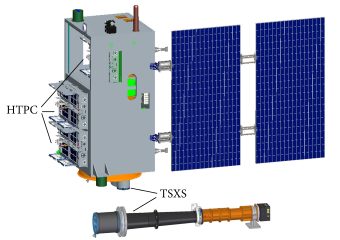|
|
XPNAV-1

The X-ray Pulsar Navigation (XPNAV-1) satellite is small satellite designed
and developed by the China Academy of Space Technology (CAST). It aims to
observe a number of X-ray pulsar sources and develop a database of timing
profiles in order to use them for navigation throughout the solar system.
XPNAV-1 was launched on November 10, 2016 from the Linquan satellite launch
centre aboard a Long March 11 rocket. It was placed in a 500 km altitude low
earth polar orbit (with an inclination of 97.4° and a descending node
equator transit at 6 am local time).
The satellite, which weighs 270 kg, is three-axis stabilized, can
perform up to 90 minutes of observation on a source with one or the other
of the two X-ray instruments. The mission goal is to observe as many as
26 different sources, including both isolated and binary system pulsar targets,
over a five to ten year span.
The XPNAV-1 payload includes:
- Time-resolved Soft X-ray Spectometer (TSXS) which consists of
a grazing incidence Wolter-I type lens of four nested mirror shells with a collection
area of 30 cm2 that focus X-rays onto a 15-arcmin field of view
silicon drift detector (SDD). The effective detection area is 2.4 cm2
at 1.5 keV. The energy range of the SDD is 0.5–10 keV with a spectral resolution of
180 eV at 5.9 keV. Timing was tracked with a GPS calibrated Rb clock with timing
accuracy of events of 1.5 μs.
- High Time-resolution Proportional Counter (HTPC) consists of a collimator to
narrow the field of view to 2 degrees, a microchannel plate (MCP) X-ray detector sensitive
to 1–10 keV with a 1200 cm2 collecting area and 100 ns timing accuracy.
- Support systems for ground communication, operations, power supply, and solar
panels.
Operations occur in one of four modes: self-test, scanning, default target, and arbitrary
target operations. In the self-test mode, a hood covers the instrument to allow measurement
of instrument noise. The scanning mode views a swath of sky to assess background
contributions from the sky. The two operations mode consistent of up to 90 minutes of
observation by one or the other of the two instruments (power limits prevent operating
both at the same time and they are not co-aligned), followed by a slew to orient the
solar panels to recharge the batteries. The default target mode works with a set of eight
pre-selected bright targets (include the Crab pulsar, a bright and extremely well observed
source useful for calibration and instrument verification). The arbritrary mode
uses targets uploaded from ground systems.
Operational constrains include turning off instruments during South Atlantic Anomaly
passage to prevent damage, and keeping instruments pointed at least 45 degrees off the
positions of the Sun and Moon to avoid interference.
The XPNAV-1 science objectives includes (Zang, X. et al., IJAE, 8561830 (2017)):
- Test the functionality of the instruments in space;
- Detect photons from X-ray pulsars and acquire pulsar profiles;
- Perform observations of an extended period of time to measure pulsar parameters via
X-ray instruments.
XPNAV-1 is the first of a series of planned stepping stone missions: XPNAV-1 demonstrates
fundamentals of the technology, to be followed later with a medium sized mission to time
3–5 pulsars suitable for developing a navigational database, followed ultimately
by a constellation of satellites to fully develop the use of X-ray pulsar timing for
solar system navigation.
[XPNAV-1]
[Bibliography]
[All Missions]
[by Time]
[by Energy]
Page authors: Lorella Angelini Jesse Allen
HEASARC Home |
Observatories |
Archive |
Calibration |
Software |
Tools |
Students/Teachers/Public
Last modified: Thursday, 18-Mar-2021 12:06:55 EDT
|